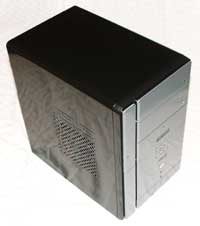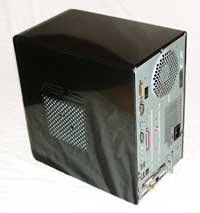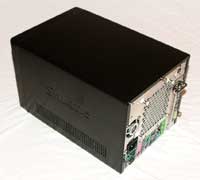Close Encounters of the Small Kind
by Jarred Walton on December 8, 2004 12:05 AM EST- Posted in
- Cases/Cooling/PSUs
Close Encounters
Writing for AnandTech puts me in something of a unique position. Few brick and mortar stores carry a large selection of SFF cases, and looking at pictures online doesn't always tell the whole story. With AnandTech, we have a large number of SFF units, many still waiting to be reviewed. (A SFF roundup will be coming soon, in case you were wondering. This is just a preface to the roundup.) The plan wasn't for me to begin using one of these cases as my own system initially, but system instabilities with one of my own computers caused me to change my mind. While I RMA the motherboard that is apparently causing problems and wait for its return, I decided to adopt one of the SFF cases for my own use - but which one?Understanding that aesthetics are a completely personal view, I checked out all of the cases. They all look pretty good, depending on your own taste - what I hate, someone is bound to love, and what I like, some will think is boring. In the end, I built two of the units just for purposes of a "test drive" and I picked what are basically the two extremes of the SFF genre.
 Click to enlarge. |
 Click to enlarge. |
On the one hand, we have the ASUS T2-P Deluxe. Depending on your point of view, it may not even qualify as a true SFF design. Featuring two CD/DVD slots, a 3.5" floppy bay - the floppy drive is actually included with the case - and an internal 3.5" HDD, not to mention a ton of other extras, the ASUS SFF includes everything and the kitchen sink. (The manual states that a CD/DVD drive is also included, but it was not present in this unit. This is possibly due to the fact that this unit was sent for review purposes, but it could also just be an error in the manual. We will try to get the official word from ASUS for the formal review; for now, it has a spare DVD-ROM in it.) Audio, fast Ethernet, USB2.0 and IEEE 1394a Firewire are pretty much standard features on any SFF. Add to that a six-in-one flash card reader, gigabit Ethernet, a radio tuner and antenna, integrated graphics, 802.11G wireless networking, and even serial and parallel ports, and you have a package that leaves little to be desired in terms of features. ASUS does limit your expansion options in one area, however. Many of the extras are included on a PCI add-in card, so your expansion card options are limited to adding an AGP graphics card.
 Click to enlarge. |
 Click to enlarge. |
The other unit is the latest from Shuttle, the XPC G5. Shuttle has been in this game longer than any other company, and after taking a look at all of the units stacked up, the design of their latest G5 model caught my eye. It's available in a few different formats: socket 775 with an 875P or 915P chipset and socket 939 with the Nforce3 250 Ultra chipset. Shuttle also has many other non-G5 XPC models that are worth checking out. Since the graphics card that would be used was an AGP model, PCI Express and the 915 chipset models were out of consideration. The system won't be used much for gaming, and the GPU would be the limiting factor anyway, so I ended up with the SB77G5 instead of the SN95G5. If I were actually to recommend an XPC model, I would choose the SN95G5 normally, but I wanted to try out a socket 775 system, as I had not yet done so. The features of the SB77G5 are similar to the ASUS T2-P Deluxe, only with less "extras". You get Firewire, USB2.0, Gigabit Ethernet, one 5.25" external bay, one 3.5" external bay, and one 3.5" internal bay. There's a good reason for the lack of extras, of course. The Shuttle XPC G5 is one of the smallest SFF cases out there.










45 Comments
View All Comments
fitten - Wednesday, December 8, 2004 - link
I have had two Shuttle SN41G2s for almost two years now and I like them a lot. However, for my next SFF build, I'm going to go with an Antec Aria case and a microATX motherboard because it gives more options than the barebones SFFs while being only a little larger (but still plenty small enough to carry to our frequent mini-LAN parties).As a sidenote, my wife really likes her SN41G2, even more than the A64 3000+ I built for her a few months ago (mid-tower case), just because the Shuttle is "cute" and small.
jediknight - Wednesday, December 8, 2004 - link
Maybe it's just me, but personally I don't find the idea of spending more money for something that's less expandable appealing.Certainly, for some a SFF case is a godsend.. but for me, it's the big 'ol beige case or bust :->
Scott333 - Wednesday, December 8, 2004 - link
For the roundup, please mention the number of front and back USB ports, not that Anandtech would leave it out ;)My only complaint about the article was the description of the lacking Parallel port (like ieya). It's practically a non issue for most people, and in a sense I have distaste for computer makers that insist on essentially useless legacy support. For example, I want my next PC to not have a 3.5 inch floppy drive nor a cd-rom, so even if they came free I wouldn't buy it.
The option for people who need it is exactly what they should have. Besides, you can get USB printers for free (plus 50 dollars for ink of course :).
Then again, I'm sure most readers wouldn't see your comment as a true fault of the Shuttle, just that I agree with Ieya, its very far from a deal killer.
Good article, looking forward to the details.
nastyemu25 - Wednesday, December 8, 2004 - link
jkostans, software has changed since 200mhz was top of the line... and it has also changed since 1.13ghz was top of the line. i use office suite 2003 apps at work on my p4 2ghz that run significantly faster than they do on my 1 ghz tb at home.jkostans - Wednesday, December 8, 2004 - link
I'm sorry but if you feel you need patience to use a 1.13Ghz P3 computer then you've got some problems. You must have been going out of your mind when the pentium pro 200Mhz was top of the line....... I use a 600Mhz SPARC processor at work everyday and it's no slower for browsing than my XP 3000+ back home.ieya - Wednesday, December 8, 2004 - link
As to the lack of parallel port on the Shuttle SFF, it's almost certainly an option; I built my mum a Shuttle box recently, using the nForce2 based one with integrated graphics.It, too, lacks a parallel port (interestingly enough the newer and higher-end SN84G4, which I built my dad's XPC around, does have a parallel port), however there's a cutout at the top of the case for one, and it's a cheaply available option from the same suppliers as you get the Shuttle XPCs on. Basically a parallel port with a cable which plugs onto a header on the mobo ...
So basically just to note that the lack of parallel port needn't be a 'deal killer' on the XPCs :)
athrap - Wednesday, December 8, 2004 - link
One thing I want to be addressed in the next article on SFF is the heat issue. I live in a HOT area and my computer room does not have air-conditiong. Even with a normal case, heat builup becomes a problem here in summer. Therefore, I want to know how much difference is there between an ATX case and SFF case as far as cooling is concerned.bandrade - Wednesday, December 8, 2004 - link
I'm also looking forward to the roundup. Especially if it includes high end SFF with 939 sockets and the best mid-level ones according to price vs. performance. This will definitely help me decide what to get.IceWindius - Wednesday, December 8, 2004 - link
I really wish Shuttle would get with fixing the Cold boot, SATA and incorrect temp problems with the SN95GJarredWalton - Wednesday, December 8, 2004 - link
Thanks for the comments! I believe the front image is now fixed - I missed the standard format size initially and had to tweak it.If this wasn't entirely clear, I *really* like the change from a large ATX case to a SFF. The Shuttle in particular is really sleek. Now I just need to get around to the actually replacing most of my furniture. Brown particle-board desks that have seen better days with a hodge-podge of couches and chairs - it's pretty bad. (And we won't even talk about all the computer boxes and parts around the house.) :)